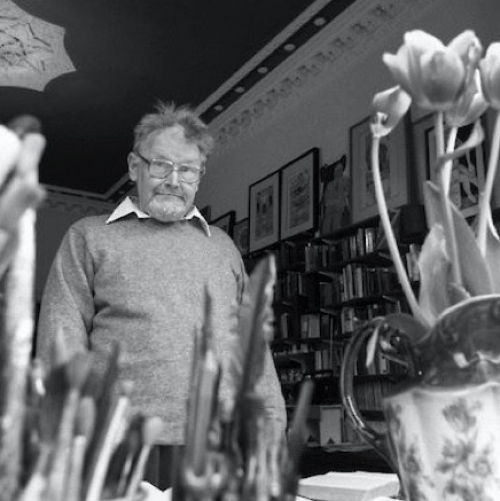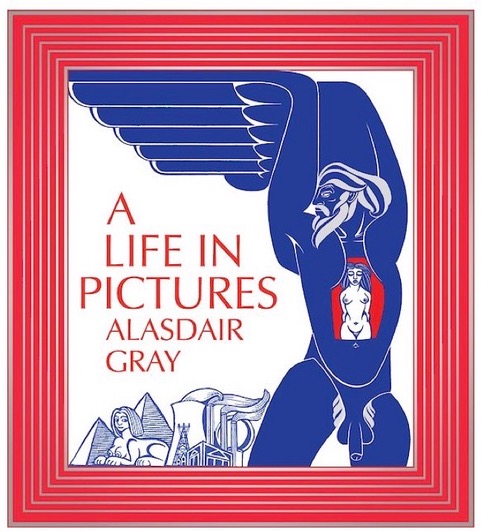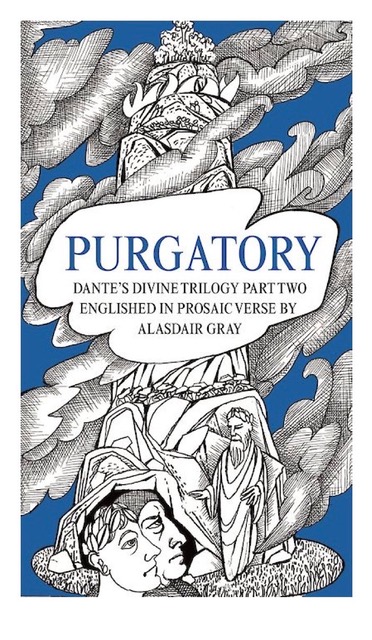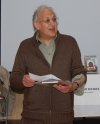A well-built wall, or other work of art: Alasdair Gray

David Betteridge takes us along Glasgow’s Byres Road, enjoying several works of public art by the late Alasdair Gray, who died on 29 December, 2019, the day after his 85th birthday
Perhaps the best thing I could do is write a story in which adjectives like commonplace and ordinary have the significance which glorious and divine carried in earlier comedies. What do you think? - Alisdair Gray, Lanark
I
This is a stub. Many more hands and minds besides my own would have to be set to work, to write a piece giving proper value to Alasdair Gray’s achievements. Like his admired William Blake, he was an artist as well as a writer, a lover of both the epic and the miniature, a deviser of both encyclopedias and minute particulars. He ranged over many genres, deploying details from his own life (a long one) and his own city (Glasgow), but at the same time he regarded the whole world with its many cultures and many histories as his oyster (not forgetting the cosmos in which the world has its unique place). He was, as Ali Smith wrote in an eloquent short obituary, “a renaissance man”. He was, she judged, the very heart of that revival in Scottish life to which he contributed, and from which he drew strength.
A walk of a few hundred yards along Byres Road, in Glasgow’s West End, affords a good introduction to the man and his work.
II
On the corner overlooking the Botanic Gardens, there is a former church, now converted to a bar, restaurant and performance area called the Oran Mor, which in Gaelic means “big song” or even, some would have it, “great melody of life”. That epithet describes Gray pretty well.
As you enter the Oran Mor from Byres Road, look down at the white and grey marble floor of the porch. There, carved into the tiles, you will see “WELCOME”, in 32 languages. Gray took great care with the lettering of this message, as with every aspect of every part of his quite substantial contribution to the Oran Mor’s conversion. For all those words of greeting that were in the Roman alphabet, he designed his own lettering, using sans serif block capitals that slightly taper away from you as you read them. This lettering he called Oran Mor Monumental.

Go to the third floor. There, extending across the breadth and length of the ceiling, you will see one of Gray’s largest and most ambitious works: a painting that combines myth and legend, Biblical reference and astronomical lore. “It’s a song of praise to the colour blue,” wrote Figgy Guyver, after a visit she paid to view it, and also “a heartfelt, humanist plea for people to come together for a better future.” This plea is directly expressed in words, as well as art. In gold lettering, across the roof beams, we read: “Work as if you live in the early days of a better nation.” This motto, borrowed from the Canadian author Dennis Lee, has been widely adopted as a motto for modern progressive Scottish politics, thanks to Gray’s use of it.
Looking up, you will see a cross-section of Creation boldly and beautifully represented. As in Gauguin’s famous Tahitian triptych, big questions are asked: “Where are we from? What are we? Where are we going?” and answers are given, if we search for them. The planets and the Milky Way give us a sense of Time and Space. The Tree of Life drives its roots into fossils and skeletons. A varied fauna and flora inhabit land, sea and air. A naked Adam and Eve kneel, entwined in one another’s arms. A phoenix rises.
The present day and the present city are not forgotten, either. Contemporary citizens, including folk who worked on, and work in, the Oran Mor have their likenesses portrayed here, honouring their labour. Gray’s is a democratic intellect, and a democratic aesthetic, and a democratic structure of feeling.

As you leave, as a companion piece to the “WELCOME” on the way in, you will see, and walk on, a set of 32 carved tiles bidding you “GOODBYE”. Many of Gray’s books end on a similarly friendly note, from his early masterpiece Lanark onwards, as if he wanted you to feel that reading the books was akin to visiting him, maybe at home, maybe in a shared public space, and he was your host. “Goodbye,” he says, as you turn the last page. I see him as a latter-day Interpreter, as in Bunyan’s The Pilgrim’s Progress. In his House, we are shown “excellent things, such as would be helpful to [us]”.
In fact, the more you immerse yourself in the print-world of Gray’s published works, the more parallels you discover between them and buildings. As you make your way through them, the books seem to have doors and windows, and rooms and corridors, and stairs and landings, with good labelling and sign-posting so you do not get lost, all in Gray’s distinctively bold, clear style.
Gray was fortunate in having Canongate as his publisher for Lanark, as for many subsequent books, as its owner Stephanie Wolfe-Murray gave him creative control over all aspects of its look, from the grand plan of the art-work to the details of line-spacing and indentation. Like William Blake or William Morris before him, Gray was enabled to work in the combined roles of artist, artisan and author.
III
After leaving the Oran Mor, turn left along Byres Road, and very soon you come to Hillhead Public Library. It was much used by Gray in the second half of his life, when he lived at various addresses in the West End, just as, in his earlier years in the East End, Riddrie Public Library had been a favourite haunt, being almost a home from home for the inveterate bibliophile.
In his retrospective memoir, A Life in Pictures, Gray tells of an occasion when one of his teachers at Whitehill Senior Secondary School invited him to give a lecture to the school’s Literary and Debating Society. This he did, with specially drawn illustrations projected on an epidiascope. These illustrations are recognisably by the same hand, and from the same mind, as all his later art-work, including the Oran Mor ceiling. Gray appears to have developed his skill and found his genius very young. His chosen subject for the lecture was “A Personal View of History”, no less, typically encyclopaedic. He started with The Ice Age and The Stone Age, and ended with The Industrial City and The Triumph of Socialism.

Along this onward march, full of epic horrors, two sunnier episodes are celebrated. Babylonian priests are pictured “recording an eclipse, having devised an alphabet and calendar that made writing history possible”. Later, the schoolboy lecturer showed his audience The Sermon on the Mount, when Jesus tells the people of the slave-based empires of the world that “every human soul was equally valued by God”. Regrettably, his art-work for that episode was mislaid, as he explains in A Life in Pictures.
For the end-point of History, The Triumph of Socialism, he chose as example and symbol the nearby Riddrie Public Library. “I thought,” he tells us, “this well-planned, well-stocked public library was a triumphant example of local egalitarian democracy.” Here we find the bedrock of Gray’s later more developed politics. He never lost his youthful Spirit of Forty-Five. Again, as with The Sermon on the Mount, we only have his word for it, as, for some reason, the drawing of the Library “was to be”, but was in fact never actually drawn.
IV
I started writing this short guide to Gray’s visible legacy in Glasgow’s West End shortly after his death at the very end of 2019. For inspiration, and for refreshing my memory, I followed the route that I am here recommending. Arriving at the wide inviting entrance of Hillhead Public Library, I found that I could not pass it without going in.
There, next to the librarians’ issue desk, was a display of all Gray’s books that they had in stock, and a table set aside where his fellow-readers were invited to sign a book - not so much a Book of Condolences, more a Book of Celebrations. Already, after only a few days of the library and the book being open after the New Year holiday, page upon page of entries had been written. As I read through them, I became aware that “Alasdair” had been well-loved as a local worthy, a kindly man, and a great conversationalist, as interested in his interlocutors as in himself; but, at the same time, “Gray” was well-regarded as an important author-cum-artist, who had put his native Glasgow and Scotland on a world map, and also brought the world to the very streets of this city. This “fat, spectacled, balding, increasingly old Glasgow pedestrian”, as he once described himself, had made his mark, a large and indelible one.
There is a point of correction to be made regarding Gray’s self-description as a “pedestrian”. For his final few years, after a fall that nearly killed him, he was a wheelchair user. Undaunted, after seven months in hospital, he was to be seen again, visiting his favourite places, going about his many ploys, and continuing his last great project, his re-telling of Dante’s Divine Comedy. How like Blake, who also immersed himself in the old Tuscan’s Hell, Purgatory and Paradise!
V
After Hillhead Library, proceed further along Byres Road to another place where Gray’s presence is felt, namely Hillhead Subway Station.

Look across the entrance hall, beyond the turnstiles that lead to the platforms and trains. There, confronting you, is Gray’s final work of public art, a mural made of ceramic tiles, two metres high and twelve metres wide. “All Kinds of Folk” it is called, and so it is identified in elegant lettering to the left. Alternatively, it is called “Folk of All Kinds”, to the right. In the middle is a panoramic view of the streets and buildings of Hillhead, the busiest part of the West End. The panorama is so boldly three-dimensional that you can imagine yourself walking there. It is flanked on both sides by panels of equally bold drawings of the very kinds of folk whom Gray imagined using the subway.
He gives us Lucky Dogs and Financial Wizards, Hard Workers and Brain Babies, Lovely Mums and Bonny Fechters, Lassies and Lads, Cocky Chaps, and others. A|few beasts and fairy-tale figures are thrown in for good measure, including Urban Foxes, Fiery Dragons, Birds of Paradise, and Unicorns. The effect is to make you smile, and that was Gray’s intention, as he indicates in a bit of verse inscribed on the wall:
Do not let daily to-ing and fro-ing
To earn what you need to keep going
Prevent what you once felt when wee
Hopeful and free.
Now look below the station’s “Exit” sign. There, in black block capitals, you will read that same motto that you saw in gold on the Oran Mor ceiling, regarding early days, a better nation, and working. Those block capitals, by the way, like all the lettering here, were specially designed for this project. They are based on Gray’s own handwritten letterforms, for that reason being known as Gray Display.
VI
I had got this far into writing my piece, when Covid-19 closed down everyday life as we are used to living it. The three places that I have described above - the Oran Mor, the Library, and the Station - are now in lockdown, as is a fourth place that I would have directed you to, namely a restaurant and bar in a lane off Byres Road, the Ubiquitous Chip, the decor of which, on a lavish scale, was Gray’s work. (He was paid for doing it, it is said, by the promise of free dinners for ever.)
It was my intention to illustrate my conducted tour with photographs taken specially for it, but that cannot now be done until Glasgow and the world return to the old normal, for good and ill, supposing that is possible. What with “self-isolating” and “social-distancing”, and shutters being up, it is as if we are suddenly inhabiting a nightmarish or dystopian or purgatorial or infernal scene of a kind that Gray might have included in the “Unthank” chapters of Lanark. You can, however, find plenty of already existing photographs online, and so compose your own visual commentary for the itinerary. You might well begin here and then progress to Gray’s official website, and then delve into his publisher’s website.
My thanks are due to Canongate for giving me permission to enliven my text (above and below) with illustrative material from their files. Maybe, post-Covid-lockdown, I will be able to return to my tour of Gray venues and take photos of my own, for splicing in.
How, then, are we to leave this inconclusive ramble? There is no better way than in Gray’s own words. In an interview that he gave in the year before he died, to Gutter magazine (Spring, 2018), he remarked on the pleasure he took from being able to work and create, even in old age and ill health; in fact, especially in old age and ill health. At the time, he was putting the finishing touches to the “Heaven” part of his Divine Comedy, “Englished in prosaic verse”, as he put it, after Dante. In words that reveal a great deal about himself, Gray concluded the interview as follows:
Everyone who makes something that survives them has overcome death to that extent: especially if it is another human being. It may also be a well-built wall or other work of art.

VII
ENOUGH TO LIFT MY EYES TO
An imagined meeting with Alasdair Gray,
in a Glasgow street
“There’s not a street in Glasgow,
Anyplace, or Purgatory that I don’t know.
I’ve sojourned here for all my years,
studying the root and consequence
of the world’s good and the world’s ill,
watching both succeed, pondering
how the one can let the other grow.”
Looking up intently from his wheelchair,
like a tree’s last stubborn leaf
lit by a late sun, in a winter’s wind,
not torn, not shaken even,
he held my attention as he spoke.
I thought of the Ancient Mariner,
as for a long moment he had me
in his close focus there.
We were like two islands in a flow
and counter-flow of passing folk.

“For self-protection,” he explained,
“or, if hurt, self-heal, I carry with me
images and words that speak truths,
some from the past, some being formed.
Reviewing them can feed them present life,
and make them for a moment real.
“Whoever harrows any kind of Hell
must do the same. But…” -
he cautioned with a work-worn hand -
“know this: there is no certain Paradise
at journey’s end, perhaps no journey’s end;
but I have seen, for sure,
occasional glimpses of a far-off hill,
part-grey, part-green, chequered bright.
“It is not the steep slope
that Dante wrote of in his Purgatorio.
Rather, it is some high point,
beyond our city’s boundary,
that catches now and then whatever rays
there are of the day’s light.
It is enough for me to lift my eyes to.”
Then, "Look!" he cried,
and gave a sudden whoop of joy,
pointing across the street to where,
in a park, a chestnut tree stood tall.
“Imagine,” he said, “imagine playing there,
swinging on a knotted rope,
collecting conkers, being Tarzan,
being a dryad, trying not to fall.”
Studying that tree, we saw -
he made me see - a rain of golden orioles.
As if so many falling meteors,
as if directed by a hidden hand,
in a swoop, they cascaded to the tips
of the bare boughs.
There they perched for a short while,
overlooking the neighbouring ground.
Talismans, they flashed forth
against the evening’s blue.
I see them now, transfiguring
the landscape of my mind’s-eye view.

David Betteridge
David Betteridge is the author of a collection of poems celebrating Glasgow and its radical traditions, 'Granny Albyn's Complaint', published by Smokestack Books in 2008. He is also the editor of a compilation of poems, songs, prose memoirs, photographs and cartoons celebrating the 1971-2 UCS work-in on Clydeside. This book, called 'A Rose Loupt Oot', was published by Smokestack Books in 2011.
